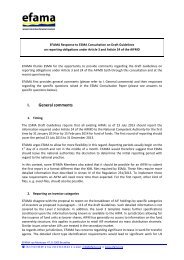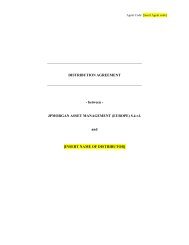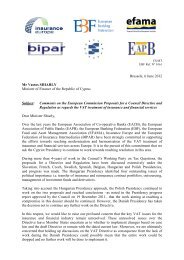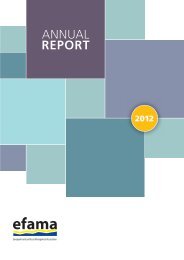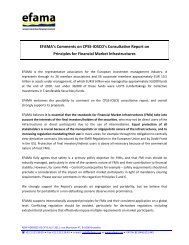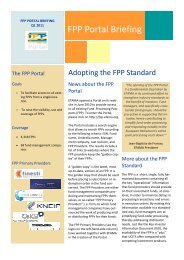EFAMA KPMG Solvency II Report
EFAMA KPMG Solvency II Report
EFAMA KPMG Solvency II Report
You also want an ePaper? Increase the reach of your titles
YUMPU automatically turns print PDFs into web optimized ePapers that Google loves.
2 EXECUTIVE SUMMARY | 9<br />
Challenges and Impacts<br />
Granularity –The need to provide data for each asset held on a security-by-security<br />
basis will represent a significant challenge for insurers, particularly where they hold<br />
large diverse investment pools across multiple service providers.<br />
Complementary Identification Codes – Assets need to be classified by means of<br />
a Complementary Identification Code (CIC), however the CICs are ambiguous and<br />
an asset manager may be required to allocate a single asset into different CICs for<br />
different insurers. This will increase the effort at the asset manager and may result<br />
in inconsistent treatment of an asset by insurers.<br />
Look-through data – Insurers must be able to ‘look-through’ fund of fund and other<br />
investment structures to identify the ultimate asset. This will necessitate a dramatic<br />
increase in data exchange between asset managers within a given asset hierarchy<br />
and require an increased level of disclosure between asset managers.<br />
Ad-hoc data provision – Data that is provided on ad-hoc basis is subject to the<br />
same quality and governance standards as the data provided on a periodic basis, but<br />
the very nature of these requests means that their data set and timescales cannot<br />
be standardised. The changes needed to comply with this requirement may prove<br />
costly and require considerable time and effort. Such requests would also limit the<br />
level of data quality testing that the asset managers could apply to the ad-hoc data.<br />
Data delivery – The absence of a common standard for data transmission<br />
between asset managers and insurers will greatly increase the complexity of data<br />
governance, management and transmission.<br />
Data exchange formats – Much of the granular data supplied by an asset manager<br />
will be disclosed directly via an insurer’s Quarterly <strong>Report</strong>ing Templates (QRTs),<br />
however the format and content of these QRTs have yet to be finalised by the<br />
European Insurance and Occupational Pensions Authority (EIOPA) and organisations<br />
have little choice but to design their solutions around current QRT versions.<br />
Data licensing –The current structure of data licences and the diversity of data<br />
required to support Pillars 1, 2 and 3 of <strong>Solvency</strong> <strong>II</strong>, means that all data cannot be<br />
supplied within a single data licence and therefore insurers and the suppliers of<br />
their asset data will need to hold multiple licences with data vendors. Frequently,<br />
these licences allow for significantly more data to be provided than is required to<br />
fulfil <strong>Solvency</strong> <strong>II</strong> requirements.<br />
Data governance – Asset managers will be required to implement data management<br />
processes that are at least equivalent to those at their clients, however the standards<br />
will vary across insurers and it may prove challenging for asset managers to<br />
demonstrate that their processes are adequate for all their clients.<br />
Data quality –The <strong>Solvency</strong> <strong>II</strong> Directive requires insurers to demonstrate that the<br />
data they use are accurate, complete and appropriate data, regardless of whether<br />
the data were sourced internally or externally to the insurer, and insurers are looking<br />
to their asset managers to assure them that the asset data they receive meets<br />
these standards. This poses several challenges to asset managers and third party<br />
administrators, in particular the tight timescales to perform quality testing and<br />
remediate errors, the frequency of such testing and the additional costs that this<br />
will bring (including implementing tools to automate quality checking).<br />
© 2012 <strong>KPMG</strong> LLP, a UK limited liability partnership, is a subsidiary of <strong>KPMG</strong> Europe LLP and a member fi rm of the <strong>KPMG</strong> network of independent member fi rms affi liated with <strong>KPMG</strong> International<br />
Cooperative, a Swiss entity. All rights reserved.





